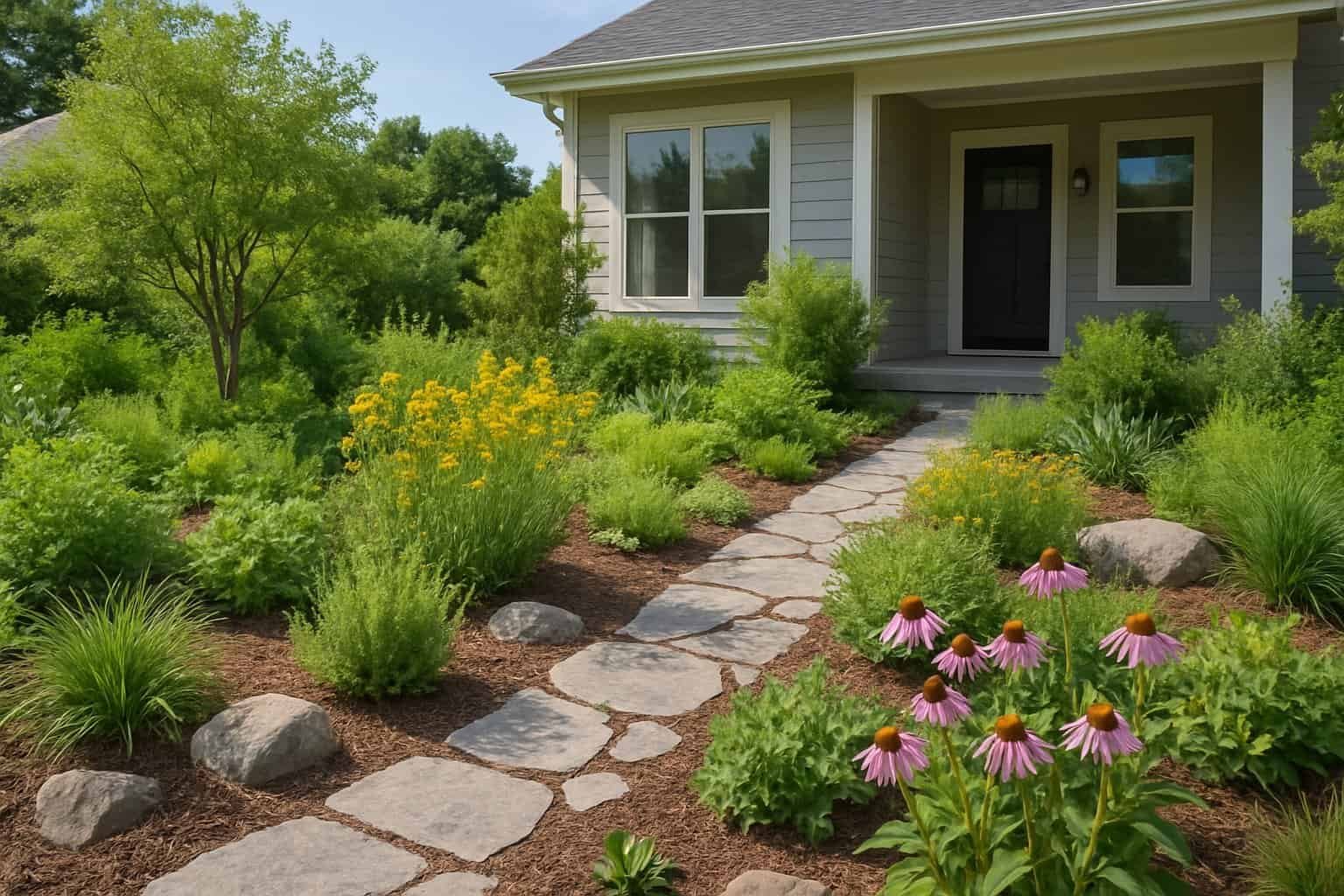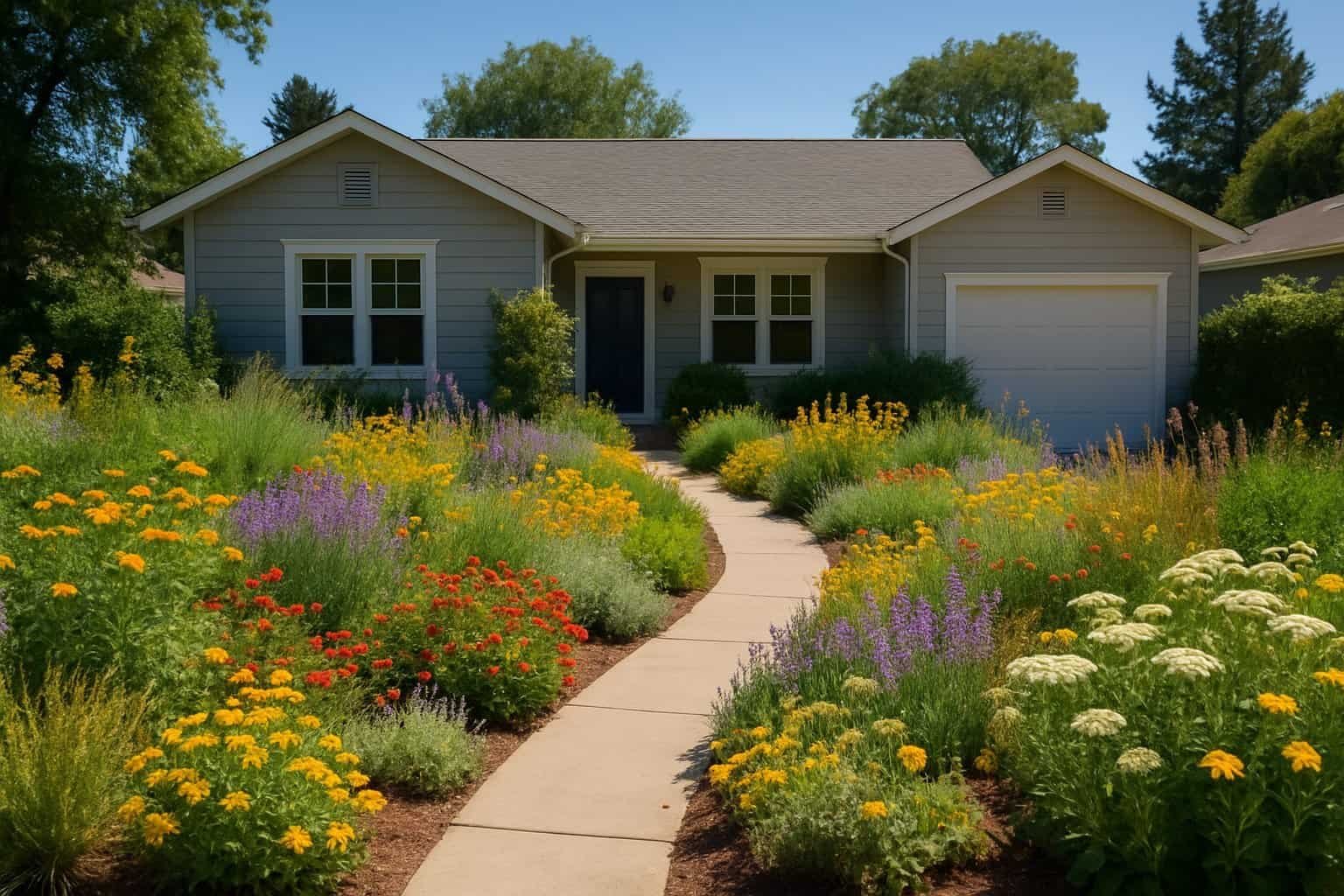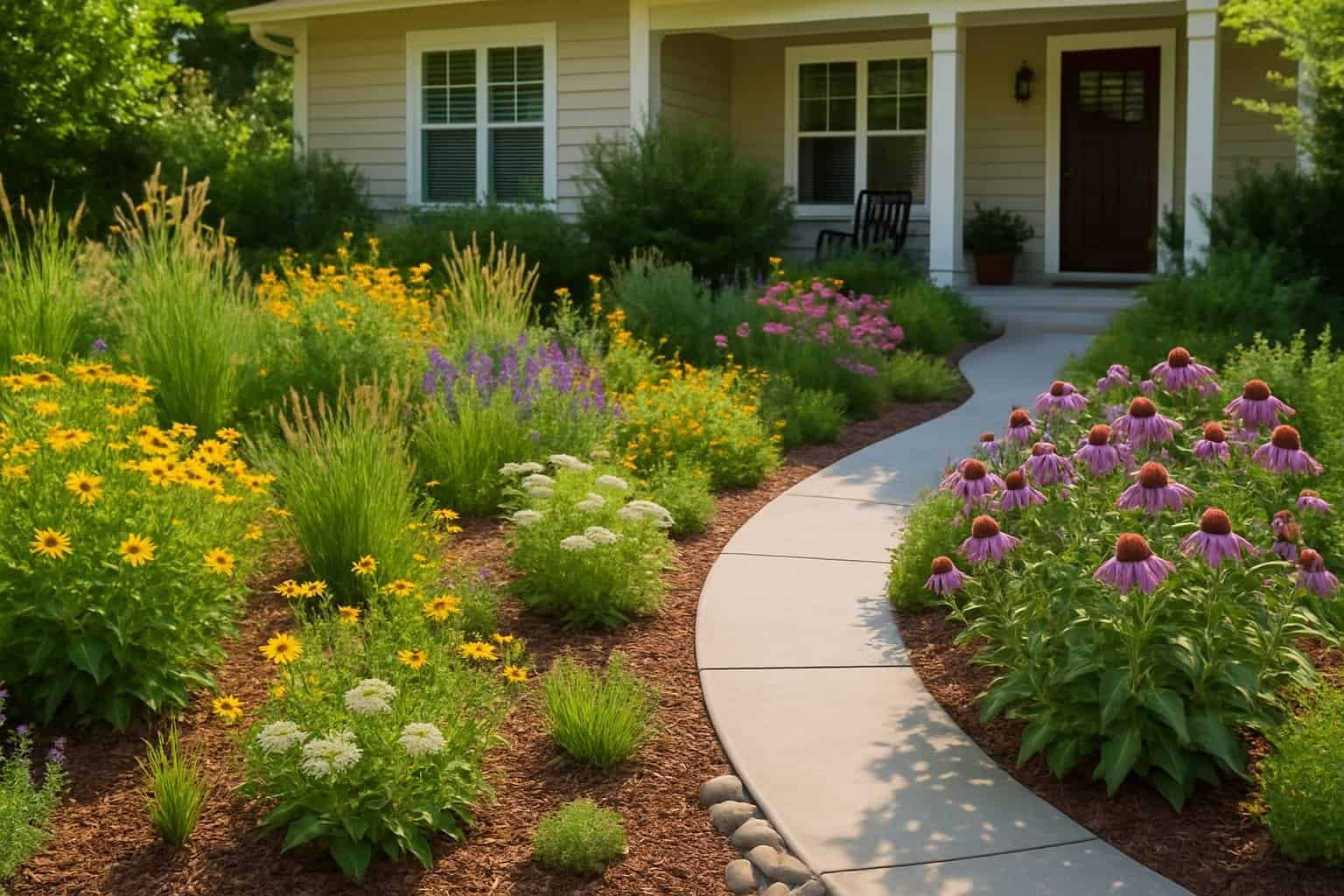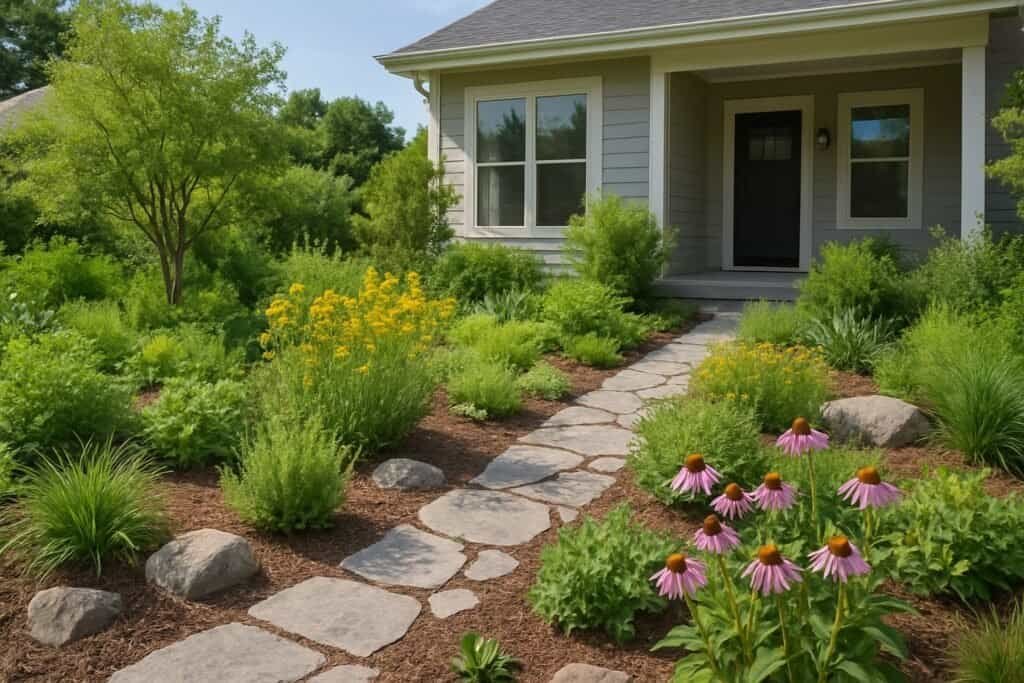Native plant gardens turn ordinary front yards into vibrant ecosystems that attract local wildlife and reduce maintenance. These designs combine beauty and functionality, helping your yard stand out while supporting the environment.
A well-designed native plant garden can use up to 75% less water than traditional lawns and provide essential habitats for pollinators and birds.

Start planning your front yard native garden by learning about your local ecosystem and the plants that naturally thrive in your area. Consider your soil type, sunlight, and climate when choosing plants.
This approach helps you create a garden that looks great all year with little effort.
Key Takeaways
- Native plant gardens use up to 75% less water and need less maintenance than traditional lawns while supporting wildlife.
- Begin by understanding your region’s growing conditions and choosing suitable local plant species.
- Use a mix of heights, textures, and plants with seasonal interest for visual appeal and ecological benefits.
Benefits of Native Plant Gardens for Front Yards

Native plant gardens make front yards beautiful and eco-friendly. They add curb appeal, support local ecosystems, and cut down on maintenance.
Enhancing Curb Appeal
Native plant gardens create unique, eye-catching yards that stand out among traditional lawns. These gardens offer year-round interest with changing foliage, flowers, and textures.
Many native plants bloom in vibrant colors, produce interesting seed heads, and show off brilliant fall foliage. You can design native gardens in formal styles with neat edges or in naturalistic, meadow-like layouts.
The key is thoughtful planning and plant selection.
Design Tips for Curb Appeal:
- Group plants in odd numbers (3, 5, 7) for a natural look.
- Use varying heights, placing taller plants at the back.
- Add structure with native shrubs or small trees as focal points.
- Define spaces with stone pathways or borders.
Supporting Pollinators and Wildlife Habitat
Native plant gardens provide vital habitats for local wildlife. Native species have evolved with local pollinators and animals, making them ideal food and shelter sources.
Butterflies, bees, and hummingbirds rely on native flowering plants for nectar. Native gardens help restore habitats that pollinators need.
Birds eat seeds and berries from native plants and use plant material for nesting. Even small front yard gardens can become wildlife corridors that connect larger natural areas.
Wildlife-Friendly Plant Features:
- Tubular flowers attract hummingbirds.
- Flat, clustered blooms support butterflies and bees.
- Berry-producing shrubs feed birds.
- Dense foliage shelters beneficial insects.
Water Conservation and Drought Tolerance
Native plants need much less water than traditional lawns or exotic ornamentals. Once established, many native species survive on rainfall alone.
Their deep roots help them reach groundwater during dry spells. This reduces irrigation needs and prevents soil erosion.
Native plant gardens save water and time by eliminating the need for frequent watering. This becomes especially important in areas with water restrictions.
Water-Saving Benefits:
- Minimal or no irrigation needed after establishment.
- Lower water bills.
- Less runoff and better soil health.
- More resilience during droughts.
Essential Principles of Front Yard Native Plant Garden Design

Start your native plant garden by understanding your site conditions and making smart design choices. Careful planning helps your garden thrive and look appealing in every season.
Assessing Soil Type and Light Conditions
Map out the light patterns in your front yard. Note which areas get full sun (6+ hours), partial sun (4-6 hours), or shade (less than 4 hours).
These patterns help you choose the right native plants for each spot. Test your soil to see if it’s sandy, clayey, or loamy.
Native plants have adapted to specific soils, so knowing your soil type guides your choices. You can use a simple soil test kit or send a sample to a local extension office.
Watch how water drains after rain. Find wet and dry spots in your yard.
Some natives like moist soil, while others need well-drained ground. Matching plants to these conditions reduces maintenance and helps them survive.
Planning for Bloom Times and Seasonal Interest
Plan your garden so something always looks good. Make a bloom calendar with plants that flower in different seasons.
Spring could feature columbine and wild geranium, summer might show off coneflowers and bee balm, and fall brings asters and goldenrod.
Year-Round Interest Chart:
| Season | Plant Examples | Visual Elements |
|---|---|---|
| Spring | Columbine, Wild Geranium | Early blooms, fresh foliage |
| Summer | Coneflower, Black-eyed Susan | Peak flowering, buzzing pollinators |
| Fall | Asters, Little Bluestem | Seed heads, autumn colors |
| Winter | Red Twig Dogwood, Ornamental Grasses | Structural elements, snow catchers |
Choose plants with interesting seed heads, bark, or winter shape. Evergreen groundcovers add color in winter when other plants are dormant.
Native grasses add movement and texture through all seasons.
Incorporating Focal Points
Focal points draw attention and add interest to your garden. Plant a specimen tree like redbud or serviceberry as a centerpiece.
Use large boulders or features like bird baths to complement native plants and provide wildlife habitat. Place these where you can see them from the street and your windows.
Group plants in odd numbers (3, 5, or 7) for a natural look. Put taller plants at the back and shorter ones up front.
Think about how the garden looks from different angles. Add a bench to invite visitors to enjoy the space.
Choosing and Combining Native Plants
Select and arrange native plants that naturally grow in your area. The right combinations create year-round beauty and support wildlife.
Selecting Native Flowers, Shrubs, and Trees
Native flowers bring color and life. Choose varieties that bloom at different times for continuous color.
Coneflowers, black-eyed Susans, and bee balm attract pollinators and look great. Native shrubs give structure, privacy, and food for wildlife.
Serviceberry, ninebark, and viburnum offer flowers, berries, and fall color. Trees anchor your landscape and add height.
Pick species that fit your yard size. Small trees like redbud or dogwood suit small spaces, while oaks or maples fit larger lots.
Think about mature plant sizes. Place shorter plants in front and taller ones in back to add depth.
Mixing Native Grasses and Wildflowers
Native grasses add texture and movement. Little bluestem, switchgrass, and prairie dropseed change color through the seasons.
Mix grasses with wildflowers for a meadow effect. This mimics nature and needs less maintenance than a lawn.
Effective Grass-Wildflower Combinations:
- Short grasses with low wildflowers at the front.
- Medium grasses with mid-height flowers in the middle.
- Tall grasses with robust perennials at the back.
Let grasses stand through winter. Birds eat their seeds, and their shapes add winter interest.
Plant in drifts or clusters for a natural, unified look.
Ensuring Biodiversity and Resilience
A diverse plant mix makes your garden more resilient. Aim for at least 15-20 native species to support wildlife and prevent pest or disease problems.
Include plants that help specific animals. Milkweed attracts monarch butterflies, and asters bring in beneficial insects.
Berry shrubs feed birds in winter. Choose resilient species suited to your local conditions.
Plant Selection Strategy:
- 50% backbone plants (reliable, sturdy natives)
- 30% seasonal interest plants (showy bloomers)
- 20% specialist plants (species with unique ecological roles)
Group species that naturally grow together in the wild. They share resources well and thrive together.
Popular Designs and Layouts for Front Yard Native Gardens
Native plant gardens offer many design options to suit any home style. These layouts balance beauty and ecological benefits with smart plant choices.
Naturalistic Meadow and Recreated Prairie
Meadow and prairie designs mimic nature with loose, flowing plantings. Use native grasses like little bluestem or prairie dropseed as a base.
Add colorful wildflowers such as coneflowers, black-eyed Susans, and blazing stars for seasonal interest. The Missouri Prairie Foundation suggests starting with 15-20 species for real prairie diversity.
Arrange plants in drifts or clusters, not rows. Once established, meadow gardens need little care.
Mow once a year in late winter to prevent woody plants from taking over and to help insects overwinter. These designs work best in sunny spots with at least six hours of light.
Balance the natural look with mowed edges or clear pathways for a tidy appearance.
Butterfly Garden and Sunny Pollinator Patch
Butterfly gardens focus on plants that support pollinators through all life stages. Include nectar plants for adult butterflies and host plants for caterpillars.
Key Nectar Plants:
- Purple coneflower
- Joe-pye weed
- Blazing star
- New England aster
Important Host Plants:
- Milkweed (for monarchs)
- Violets (for fritillaries)
- Native grasses (for skippers)
Plant in groups of 3-5 for easy pollinator access. Choose plants with staggered bloom times for continuous nectar from spring through fall.
Add shallow water dishes and flat rocks for butterflies to drink and rest. Skip pesticides to protect pollinators.
Place taller plants at the back and shorter ones in front for good butterfly viewing.
Formal Native Shade Garden
Formal native gardens use structure and symmetry with native plants. Defined borders, neat layouts, and pruning create order.
Woodland natives like ferns, sedges, and spring ephemerals do well in shady yards. Layer plants with understory trees like redbud or serviceberry for structure.
Use native groundcovers such as wild ginger or foamflower under shrubs. Create paths with natural stone or sustainable materials.
Edge beds with low-growing natives like Pennsylvania sedge or wild strawberry instead of boxwood. Group plants by water needs for easy care.
Add water-saving features like rain gardens in low spots to catch runoff.
Design Features and Garden Elements
Native plant gardens thrive when you add thoughtful structural elements. These features boost beauty and function, turning a simple yard into a dynamic ecosystem that supports wildlife and looks great.
Adding Rock Gardens and Swales
Rock gardens create perfect microclimates for drought-tolerant native plants. Choose local stones that match your region’s natural landscape.
Arrange larger boulders first to set the structure. Add smaller rocks to fill in the gaps.
Native plants for rock gardens include:
- Penstemon
- Sedum
- Prairie smoke
- Wild columbine
Swales help manage water flow across your property. These shallow, planted depressions capture rainwater and reduce runoff.
Swales nurture moisture-loving plants. Dig swales perpendicular to the slope of your yard, about 6-8 inches deep.
Place swales to direct water to thirsty plants. Line them with river rocks to prevent erosion during heavy rains.
Native sedges, rushes, and iris thrive in these wet areas.
Utilizing Pots, Planters, and Linear Strips
Containers offer flexibility in small spaces and highlight special plants. Choose pots at least 12 inches deep with drainage holes to prevent root rot.
Linear strips along driveways or walkways create tidy transitions between hardscapes and garden areas. These narrow plantings can:
- Define property boundaries
- Guide visitors along paths
- Showcase seasonal bloomers
Design tip: Group containers of different heights for visual interest. Place taller pots at the back, medium-sized containers in the middle, and low, spreading plants in front.
For narrow strips, select compact natives like prairie dropseed grass, black-eyed Susans, or little bluestem. These plants tolerate tough conditions and add texture and color.
Creating a Privacy Hedgerow
Native shrubs form excellent privacy screens and provide habitat for birds and beneficial insects. Plant hedgerows 3-4 feet from property lines to allow for mature growth.
For quick privacy, choose fast-growing natives like:
- American elderberry (6-12 feet tall)
- Serviceberry (15-25 feet tall)
- Red-twig dogwood (6-9 feet tall)
- Arrowwood viburnum (6-10 feet tall)
Space shrubs based on their mature width, typically 3-5 feet apart. Mix deciduous and evergreen varieties for year-round interest and wildlife value.
Dense hedgerows also buffer noise and filter air pollution. Plant smaller native species beneath taller shrubs to create a multi-layered habitat.
Low-Maintenance Tips for Front Yard Native Plant Gardens
Native plant gardens need less work than traditional landscapes and provide habitat for local wildlife. Proper planning and routine care make these gardens easier to maintain.
Establishing a Maintenance Routine
Native plants need regular attention during their first year. Water deeply once or twice a week to help establish strong root systems.
After the first year, most natives require minimal watering except during severe drought. In spring, remove winter debris and add a thin layer of compost around plants.
Summer requires occasional deadheading to promote blooming. In fall, prune lightly and leave seed heads for birds.
Winter maintenance is minimal—leave spent stalks standing until spring to provide habitat for beneficial insects. Create a simple calendar with monthly tasks to stay organized.
Many native gardeners find that spending just 2-3 hours monthly is enough for a thriving landscape.
Managing Weeds and Invasives
Mulch helps control weeds in native gardens. Apply a 2-3 inch layer of shredded leaves, wood chips, or pine straw around plants and leave space around stems to prevent rot.
Weed early and often. Small weeds come out easier before they establish deep roots.
Use a hand tool to remove the entire root system. Plant densely to shade out weed seedlings.
Install edging to prevent lawn grass from invading. Hand-pull weeds after rain when soil is soft.
Use cardboard under mulch for stubborn areas. Remove invasive species immediately and completely, including all roots and seeds.
Adapting to Changing Conditions
Native landscapes change over time. Plants may self-seed, spread, or occasionally die out.
Group plants with similar water needs together. This practice, called hydrozoning, prevents overwatering drought-tolerant species and ensures thirstier plants get enough moisture.
During extended drought, even established natives may need extra water. Apply water at the soil level to reduce waste and disease.
In wet seasons, make sure the garden drains well to prevent root rot. Create slight mounds for plants that prefer dry conditions.
Notice which plants thrive in your yard and add more of those species. This approach creates a sustainable landscape that becomes more self-sufficient each year.
Highlighting Iconic and Regional Native Plant Choices
Native plants that define your region can become signature elements in your front yard. These locally adapted species bring authentic character and provide essential habitat for wildlife.
Showcasing Standout Plant Species
Goldenrod adds brilliant yellow blooms to late summer gardens and supports over 100 butterfly and moth species. Its bright color makes it a great focal point in sunny areas.
Swamp milkweed, with pink-purple flower clusters, thrives in moist soil and serves as crucial habitat for monarch butterflies. Plant it in groups of three for visual impact.
Prairie dropseed creates elegant clumps of fine-textured foliage that turn golden in fall. Its arching habit works well as a border or mass planting.
Compass plant makes a dramatic statement with its tall yellow blooms. Its deep taproot makes it very drought-resistant once established.
Big bluestem grass, often called “turkey foot,” provides stunning copper-red fall color and winter interest.
Regionally Appropriate Native Trees and Shrubs
Serviceberry offers year-round appeal with spring flowers, summer berries, and brilliant fall color. This small tree fits well in tight spaces or as an understory planting.
Redbud trees create spectacular spring displays with magenta flowers appearing directly on branches before leaves emerge. They adapt well to partial shade.
Toyon, an evergreen shrub native to California, produces bright red berries in winter that attract birds. Its leathery leaves keep interest throughout the year.
Manzanita’s smooth red bark and twisted branches make it an architectural standout. These drought-tolerant shrubs range from groundcovers to small trees.
Deer grass forms rounded mounds with slender flowering stalks that catch morning light. It pairs well with prickly pear cactus in desert-inspired designs.
Community Resources and Guidance
You can find support for your native plant garden journey easily. Local organizations and online resources offer valuable guidance to help you succeed.
Getting Involved with Native Plant Organizations
Wild Ones is a national group with local chapters that offers educational resources and community support. They host plant sales, garden tours, and workshops.
Many states have native plant societies that organize events and provide region-specific guidance. These groups often maintain demonstration gardens where you can see mature native plant landscapes.
Conservation districts and extension offices offer soil testing, plant identification help, and advice on managing invasive species. They also hold affordable native plant sales in spring and fall.
Community gardens and botanical gardens with native plant sections provide inspiration. Some offer volunteer opportunities for hands-on learning.
Accessing Design Inspiration and Templates
Many native plant nurseries provide free landscape design templates for different conditions like sunny front yards or shady corners. These templates specify plant spacing and mature sizes for proper placement.
Online platforms like iNaturalist help identify existing plants in your yard and suggest native alternatives. Pinterest and Instagram showcase real-world examples of native plant gardens.
Several universities offer free downloadable home landscape design guides focused on native plants. These guides usually include plant lists organized by height, bloom time, and wildlife benefits.
Public native plant gardens often publish their planting plans online. Local garden tours featuring native plant gardens allow you to meet experienced gardeners and learn from them.
Frequently Asked Questions
Native plant gardening brings many questions as you plan your front yard transformation. These answers address common concerns about design, finding inspiration, and choosing plants for your region.
What are the essential elements to include in a small native plant garden design?
A successful small native plant garden needs variety in plant heights. Place taller plants at the back or center, with shorter species in front to create depth.
Include a mix of flowering plants that bloom in different seasons. This keeps your garden colorful and provides food for pollinators year-round.
Add structural elements like rocks, logs, or a small water feature. These features create microhabitats for insects and wildlife and add visual interest.
How can I find inspiration for my native plant garden through design pictures and images?
Local botanical gardens offer real-life examples of native plant landscaping. Many have specialized native plant sections that show how these plants look in established settings.
Online platforms like Pinterest and Instagram feature many native garden photos. Search for hashtags like #nativeplantgarden or #nativelandscaping for design ideas.
Native plant societies often post photo galleries on their websites. These show member gardens and community projects that can inspire your own space.
Where can I find native plant garden design plans that are suitable for beginners?
The National Wildlife Federation offers free downloadable garden plans for beginners. Their templates include plant lists and layout guides for different yard sizes.
Many state extension offices provide native garden plans for local conditions. These resources usually include detailed planting instructions and maintenance schedules.
Native plant nurseries often share simple design templates on their websites. These plans work well for first-time gardeners.
How can I locate a landscape designer specializing in native plant gardens in my area?
The Association of Professional Landscape Designers has a searchable directory. You can filter for professionals who specialize in native plant design.
Local native plant societies often keep lists of recommended designers. These groups can connect you with experts in native plant gardens.
Ask for recommendations at specialty native plant nurseries. Staff usually know which local designers have experience with native plant installations.
What are the key considerations when planning a native plant garden in Virginia’s climate?
Virginia’s climate requires plants that can handle humid summers and occasional cold snaps. Choose species like Virginia bluebells, black-eyed Susans, and Eastern redbud trees that thrive in these conditions.
Consider Virginia’s rainfall patterns. Group plants with similar water needs and use gentle slopes or rain gardens to manage downpours.
Account for the state’s diverse soil types, from coastal sands to clay-heavy Piedmont soils. Test your soil before planting and select native species adapted to your soil type.
What specific plant choices are recommended for a California native garden to promote local biodiversity?
California poppies and lupines create stunning spring displays. These wildflowers support local pollinators and adapt well to California’s Mediterranean climate.
Manzanita and ceanothus shrubs provide year-round structure and habitat. Their drought tolerance makes them great anchors for a garden that needs little irrigation.
Native grasses like deer grass and California fescue add movement and texture. These grasses support many insect species and small mammals while needing very little maintenance once established.


